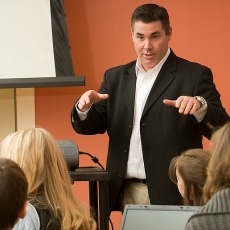“Conscientious pedagogical reflection is necessary to produce a complete, well-developed teaching philosophy. The absence of pedagogical reflection can result in daily instruction that fails to reflect an instructor’s teaching philosophy or instructional belief system accurately. In particular, an underdeveloped teaching philosophy may translate into a teaching style full of inconsistencies, characterized by poorly coordinated and designed instruction.” (p. 182)
Read more ›CURRENT ARTICLE • September 02
OTHER RECENT ARTICLES
Although they are a fairly recent innovation, most faculty are familiar with teaching philosophy statements. Many have prepared them for job interviews, for promotion and tenure dossiers, for teaching awards, or for personal benefit.
Read More › 1. Good teaching is as much about passion as it is about reason. It’s about motivating students not only to learn, but teaching them how to learn, and doing so in a manner that is relevant, meaningful and memorable. It’s about caring for your craft, having a passion for it and conveying that passion to everyone, but mostly importantly to your students.
1. Good teaching is as much about passion as it is about reason. It’s about motivating students not only to learn, but teaching them how to learn, and doing so in a manner that is relevant, meaningful and memorable. It’s about caring for your craft, having a passion for it and conveying that passion to everyone, but mostly importantly to your students.
When I started teaching 27 years ago, like the scarecrow in The Wizard of Oz I believed that just having a brain would make me successful. And so each class session I would literally “take the stage” on a raised platform to deliver what was in my head and on my papers. Even though there were 60 students in the class, there could just as well have been none because I basically ignored the students. They were objects, sponges whose task was to absorb course content.
Read More ›I was reading something yesterday that referenced Stephen Brookfield’s The Skillful Teacher. The first edition was published 1990, a second in 2006. The book is a classic.
Read More ›The midwife is still my favorite metaphor for teaching. I don’t think there’s a metaphor that more aptly captures the complexity, power, and richness of the dynamic relationship between teachers, students, and learning. The metaphor is not original with me, and although I have read some quibbles in the literature as to who first proposed it, I first encountered it in a 1986 Harvard Educational Review essay by William Ayers. Here’s some of my current thinking about how the midwife mirrors all that a good teacher should be.
Read More ›Sometimes we are so concerned with following our lesson plans to the letter that we miss what is truly important: teaching moments. A teacher has to learn to listen to his or her class and realize when the moment to abandon the lesson plan has come. This willingness to release some control over the class and allow it to develop more or less organically does not always come easily, however. Goal-induced anxiety can make a teacher reluctant to let go of the reins out of fear that the class will go off in some random direction.
Read More ›The February issue of the newsletter contains highlights from an amazing article—one written by a faculty member who describes himself as a “bad teacher.” The piece chronicles his transformation as a teacher. It’s one of the best articles I’ve read in a long while (and you know I read more than a few articles).
Read More ›What should faculty reviewers look for in a teaching philosophy statement of a candidate? Correspondingly, what should those applying for academic positions put in a teaching philosophy statement? The author of this article suggests models of teaching and learning. Of learning, he writes, “Candidates should demonstrate knowledge of models of how students learn, how best to encourage learning, and how to assess whether learning has occurred.” (p. 336)
Read More ›I once observed in a class in which the instructor returned a quiz. One of the questions indicated that an employee had just received a 10 percent raise. The employee was now making $50,000. The question asked what the employee’s previous salary was.
Read More ›




